Describe fully each of the numbered melodic intervals as highlighted below.

Intervals:
1.
2.
3.
4.
5.
In music theory, the term interval describes the relationship between the pitches of two notes. Intervals may be described as: Harmonic – if the two notes sound simultaneously. Melodic – if the notes sound successively.
To help with the interval questions it is useful to construct a piano keyboard (for counting semitones) and interval chart as shown below. Make sure you view the video tutorial on ‘interval chart’ which shows how to construct this chart and the meaning of the symbols.
Use the following chart when working on interval questions.
Interval chart
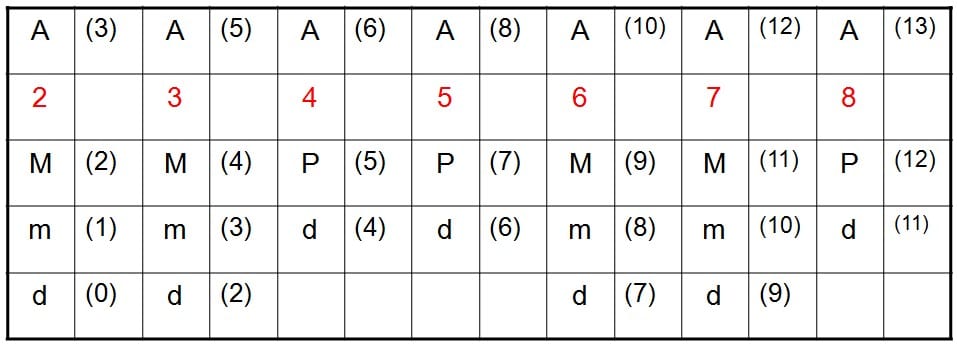
The numbers in red are the intervals of a 2nd, 3rd, 4th, 5th, 6th, 7th & 8th. The intervals of 2nd, 3rd, 6th & 7th can be either major – shown with the capital ‘M’, minor shown with a lower-case ‘m’, diminished shown with a lower-case ‘d’ or augmented shown with a capital ‘A’. The intervals of a 4th, 5th or 8th can be either perfect shown with a capital ‘P’, diminished, shown with a lower-case ‘d’ or augmented, shown with a capital ‘A’. The bracketed numbers are the number of semitones that each of the intervals contain.
We will also be using a piano keyboard so it is important to know how to write out the keys, pay particular attention to the fact that there are no black notes between B & C and E & F.

Method.
Find the numbered interval of the two notes, always count from the lowest note. Using the keyboard count the number of semitones between the lower and higher note. Use the interval chart to provide the ‘quality’ of the interval e.g. Major 2nd, Augmented 5th.
If the numbered interval was ‘3’ and the number of semitones between the two notes were ‘2’ then the interval would be a diminished 3rd.
Interval Example:
A typical question on intervals follows:
Describe fully each of the numbered melodic intervals (e.g. major 3rd )
The intervals are numbered 1 to 5. For question 1 first of all find the numbered interval. To do this count the lower note as 1, and count up to the higher note. Always work out intervals from the lower note. In the example below C# is 1, D would be 2 and E is 3. Therefore the numbered interval is 3.

Look at the keyboard below and count the number of semitones between C# and E. Be careful as this time C# is not counted as 1. As we are counting semitones between notes, C# to D is 1 and D to D# is 2 and D# to E is 3. Therefore the number of semitones is 3

Recapping – the numbered interval is 3 and the number of semitones is 3. Use the interval chart below to find the quality of interval e.g Major, minor, diminished or Augmented. To do this find the column ‘3rd’ (the numbered interval) and look for the number 3 (the number of semitones). The answer will be a minor 3rd.
Interval chart
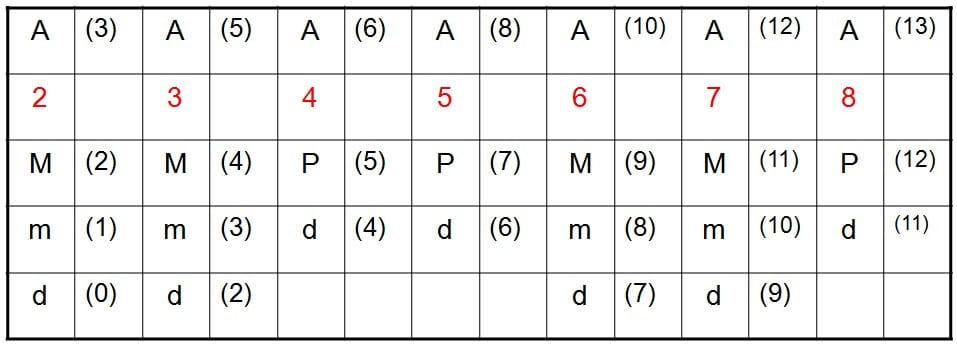
Find the numbered interval for question 2 (Bb to E). Count Bb as 1, C is 2, D is 3 and E is 4 therefore the numbered interval is 4 (always count intervals from the bottom note up).

Using the keyboard below, count the number of semitones between Bb and E. Remember Bb is not counted as 1 but Bb to B is 1. B to C is 2, C to C# is 3, C# to D is 4, D to D# is 5 and D# to E is 6. Therefore the number of semitones is 6.

Recapping, we know the numbered interval is 4 and the number of semitones is 6. Use the interval chart below and find ‘4th’ then look for the number 6. The answer is an Augmented 4th.
Interval chart
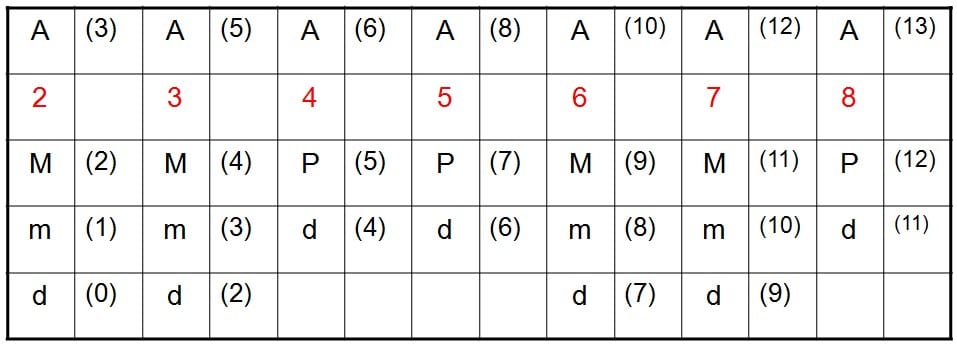
For question 3, count the numbered interval from G to E. This is 6, remember to count from the bottom note upward.

We know the interval is a 6th of some kind. To find the quality of the interval use the keyboard and count the number of semitones between G and E. Remember G to G# is 1 semitone, G# to A =2, A to A# =3, A# to B = 4, B to C = 5, C to C# = 6, C# to D = 7, D to D# = 8 and D# to E = 9. Therefore there are 9 semitones between G and E.

Recapping, we know the interval is a 6th of some sort and it contains 9 semitones. Look at the interval chart at ‘6th’ and read off against the number 9. You will see that the interval is a Major 6th.
Interval chart
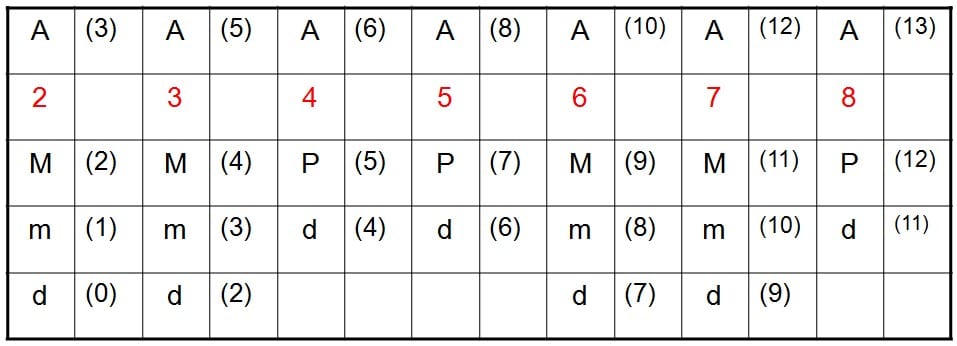
For question 4, count the numbered interval from B to F. This is 5, remember to count from the bottom note upward.

We know the interval is a 5th of some kind. To find the quality of the interval use the keyboard and count the number of semitones between B and F. Remember B to C is 1 semitone, C to C# =2, C# to D =3, D to D# = 4, D# to E = 5, and E to F = 6. Therefore there are 6 semitones between B and F.

Recapping, the numbered interval is a 5th and the number of semitones is 6. Use the chart, find the column ‘5th’ and read off against the number 6. The interval is a diminished 5th.
Interval chart
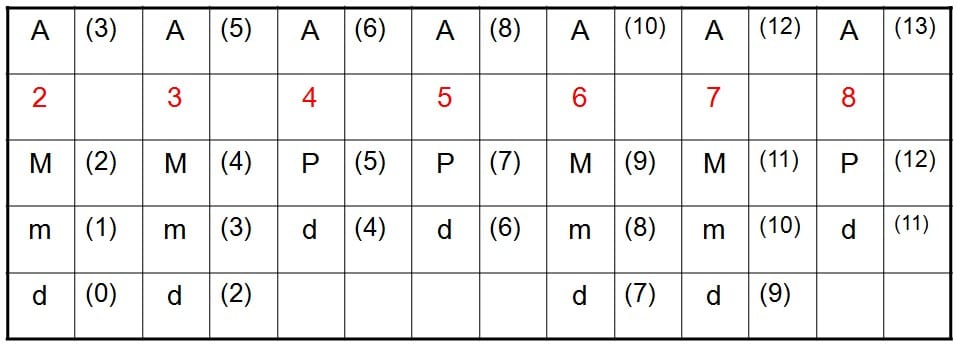
For question 5, count the numbered interval from G# to B. This is a 10th. When an interval is greater than an octave pretend the lower note is an octave higher in other words the G# is an octave above. Counting the numbered interval will give you a 3rd (G# = 1, A = 2 and B = 3). This will become what we call a compound interval and therefore we must use this term in the answer.

We know the interval is a compound 3rd of some kind. To find the quality of the interval use the keyboard and count the number of semitones between G# and B. Remember G# to A is 1 semitone, A to A# =2 and A# to B is three. Therefore there are 3 semitones between G# and B.

Recapping, we know the interval is a compound 3rd of some sort and it contains 3 semitones. Look at the interval chart at ‘3rd’ and read off against the number 3. You will see that the interval is a compound minor 3rd.
Interval chart
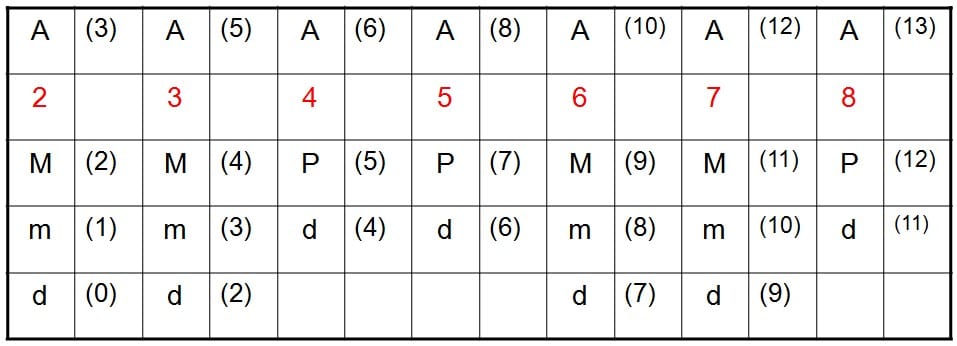
Download the following questions or write the notes on manuscript before completing.
Describe fully each of the numbered melodic intervals as highlighted below.

Intervals:
1.
2.
3.
4.
5.
Answer to: Describe fully each of the numbered melodic intervals as highlighted below

Intervals:
1. Minor 3rd
2. Augmented 4th
3. Major 6th
4. Diminished 5th
5. Compound Minor 3rd
Describe fully each of the numbered melodic intervals as highlighted below.

Intervals:
1.
2.
3.
4.
5.
Answer to: Describe fully each of the numbered melodic intervals as highlighted below

Intervals:
1. Major 7th
2. Compound Minor 2nd
3. Augmented 4th
4. Minor 3rd
5. Diminished 8th
Describe fully each of the numbered melodic intervals as highlighted below.

Intervals:
1.
2.
3.
4.
5.
Answer to: Describe fully each of the numbered melodic intervals as highlighted below.

Intervals:
1. Minor 3rd
2. Augmented 5th
3. Perfect 4th
4. Diminished 6th
5. Major 3rd
Describe fully each of the numbered melodic intervals as highlighted below.

Intervals:
1.
2.
3.
4.
5.
Answer to: Describe fully each of the numbered melodic intervals as highlighted below.

Intervals:
1. Minor 3rd
2. Diminished 5th
3. Minor 6th
4. Major 7th
5. Compound Augmented 4th
Describe fully each of the numbered melodic intervals as highlighted below.

Intervals:
1.
2.
3.
4.
5.
Answer to: Describe fully each of the numbered melodic intervals as highlighted below.

Intervals:
1. Major 6th
2. Compound Perfect 4th
3. Diminished 5th
4. Diminished 7th
5. Augmented 4th
Describe fully each of the numbered melodic intervals as highlighted below.

Intervals:
1.
2.
3.
4.
5.
Answers to: Describe fully each of the numbered melodic and harmonic intervals as highlighted below.

Intervals:
1. Perfect 5th
2. Perfect 5th
3. Diminished 5th
4. Major 6th
5. Compound diminished 3rd